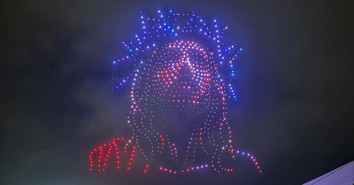12 Years A Slave: On Suffering and Salvation

“My sufferings, I can compare to nothing else than the burning agonies of hell.”
That’s how Solomon Northup, a slave in pre-Civil War America, described his decade-plus experience on plantations throughout the South in his memoir 12 Years A Slave. Now, in rather stark brutality, the film adaptation of Solomon’s story captures those sufferings in unrelenting fashion. 12 Years A Slave, which has been playing major festivals leading up to its mid-October release, is already drawing comparisons to Steven Spielberg’s Oscar-winning Holocaust epic Schindler’s List. The comparisons are apt, not just for the parallels in how race-based horrors are depicted but also in the depth and detail in which we see the systemic structure of human bondage at work.
For filmmaker Steve McQueen and his cast – which includes Chiwetel Ejiofor as Solomon and Michael Fassbender as sadistic slave owner Mr. Epps – it was important to not only depict the physical toll honestly, but the societal and spiritual tolls as well. “Steve always seems to tackle the elephant in the room,” says Fassbender – who starred in McQueen’s two previous films, Hunger and Shame. “As soon as I read the script, by the end of it I was in tears. I couldn’t believe that it was a true story and that I hadn’t heard anything about it before.”
“I wanted to tell a story about slavery,” McQueen says, “and I thought to myself, well, how do I approach this?” After struggling on a fictional narrative with screenwriter John Ridley, McQueen’s wife gave him Northup’s book. Even before he’d finished reading, McQueen (an Afro-Brit, not American) knew he’d finally found his “in” to the subject. “I thought of him (Northup) as someone who could take the audience through the ghastly conveyor belt of slavery’s history.”
That conveyor belt refers to the actual business of the slave trade itself – which included kidnapping Free Negros in the north, of which Northup was one. In the midst of a nice middle-class family existence in New York, Northup was abducted into slavery by Black Market traders. From the chaos of his perspective, we follow Northup through the system of slave trade that begins with a prolonged beating to bring him into submission.
“When we look at slavery now,” screenwriter Ridley says, “we assume it was just one thing; that blacks worked in the field. But when you have a system that suppresses the will, that is designed to dehumanize, it has to become more and more elaborate.” “We see the economics of the world,” Fassbender explains. “We see so much more than the Slave Master concept; it shows the complexity of the whole industry.”
McQueen’s depiction takes us through the gauntlet of the business itself, from initial sale (when humans are treated literally like cattle, and where families are ripped apart) to trades between owners, and eventually the inhumane cruelty of daily slave life itself – from cotton field whip-crackings to random abuse to prolonged punishments. The threat of death is pervasive.
“It was a real physical strain to re-enact this with the exact detail,” Ejiofor recalls. “It was tough emotionally and physically, but there was a feeling for me of stretching back almost two-hundred years and connecting with Solomon.”
So grueling is the depiction, co-star Alfre Woodard calls the film “a big gift” because it will help modern audiences better appreciate why slaves did not collectively revolt. “People say oh I would’ve run away, or I would’ve killed the master, but this is so complex,” Woodard says, “because [McQueen] has actually created reality, that we can not only imagine ourselves in some of these situations, but we can imagine our forbearers in these situations. It’s a reality, a day-to-day reality that I don’t think we’ve seen before.” Fassbender agrees. “It’s not a passive experience, you participate,” he says. “It’s a very rare thing for a film to achieve.”
McQueen achieves it in large part because of an observational approach that refuses to cut away. The common film language for depicting torture is to edit together a series of close, specifically-framed shots (heightened by sound effects) so as to “create” the experience. McQueen takes the opposite and more dangerous approach, lingering at length on widely-framed beatings, shifting from one tool of abuse to the next. All in one shot. Never cutting away. One wonders how the actors themselves were able to endure these prolonged takes, but as Ejiofor points out, “this was exactly what Solomon had talked about, and what he went through.”
Even with the demands that such an approach requires, Fassbender is passionate about the unforgiving effect McQueen evokes. “We’re used to seeing Master, Mid-Shot, Close-Up, but it doesn’t have to be that way…to do the long takes, it’s getting rid of these safety nets of coverage,” he explains. “It’s on. Now! All these things become palpable on the camera.” Newcomer Lupita Nyong’o, a native Kenyan who plays a key role as fellow slave Patsey (and must endure, amongst other things, both whippings and a rape), adds that it was, “challenging, heart-breaking, humiliating. But these things did actually happen.” As Woodard also defends the approach, saying, “The only way to be wrong creatively is to not go fully into the direction you’re going to. [Steve] has the bravery to play it up to the edge of the glass.”
Such brutality eventually leads to a reach toward the spiritual. But as the cast points out, the reason we see both slave and master turn to the Bible (Slaves to endure and overcome, Masters to justify) speaks not simply to the extremes of Scriptural power on one hand and Scriptural perversion on the other, but more deeply to the spiritual void created by experiences on both sides of the slavery exchange. “Man has always felt a void and wanted to fill it with something,” Woodard says, “either in dire circumstances, or putting people in dire circumstances.”
To expound on this thought, Fassbender recalls a moment when a little girl who was an on-set extra watched him prepare himself to become Mr. Epps. “I was pacing around trying to get into the head of the character and I looked up and she came into the door and she’s standing there, looking at me,” he recalls. “And she says, ‘Are you okay?’ It almost broke me down. She knew there was something wrong.” This speaks to the spiritual void, Fassbender says, because, “to be giving out pain, every day, there’s an abnormality.”
For much of the film, we see Solomon Northup experience religion only on the periphery. He respects his fellow slaves’ prayers and hymns but does not participate. But in one of the film’s most powerful scenes, Solomon has what Ejiofor describes as “a real moment of transformation”. The slaves are burying one of their own when they begin to sing the spiritual “Roll Jordan Roll”. It is here that Solomon goes from merely respecting their spirituality to engaging it.
“There’s a sense of letting go of something…it’s a bittersweet moment,” Ejiofor says. “As he watches the man being buried, he realizes this could be his fate. In order to keep on, he’s going to have to change some part of his viewpoint. The way that happens to him is that he takes onboard the community, which I think in a way he hasn’t done before. He’s a part of this other thing. He has to somehow embrace that. And alongside that, he looks to spirituality. These two aspects are what’s going to keep him alive, and he recognizes that instinctually. He doesn’t reflect or make a decision. His instinct is towards life. It’s a moment where religion impacts him for the first time. He’s always been “religious”, but never impacted by its strength – what Martin Luther King would refer to as, ‘To find a way out of no way.’ And that’s the spiritual awakening of that moment.”
Reflecting on what they accomplished, Nyong’o gushes with gratitude. “Never in my wildest dreams did I think I’d be involved in a project of this magnitude right out of drama school,” she says. “For this story in particular, I didn’t know that I didn’t know these things about slavery.” The film’s revelations don’t come necessarily through new information but rather through McQueen’s unrelenting observation of slave brutality. Even after we think we’ve got it, he stays and holds on a moment of abuse – not out of perverse fascination, but rather understanding that experience is a much more profound teacher than knowledge itself. “I’m just glad to be a part of this,” Nyong’o adds, of something “that will retain and spread these things that otherwise would not be done.”
For Ejiofer, it’s his years of experience on stage and screen that inform him of just how special this film is. “It’s so hard to imagine another opportunity like this,” he says. “I was struck by the responsibility of telling Solomon’s story, of delving into this world, and a responsibility of telling a story deep inside the slave experience. But then instead of being a responsibility it became a privilege, a real privilege to bring Solomon’s story to people, to bring that story to life.”
It was a privilege that became very personal. “I was moved by the depths of his soul,” Ejiofor confesses, “his lack of judgment, of hatred. He starts off in a battle for his freedom but then realizes he’s in a battle for his mind. Hatred isn’t going to help him, so he cuts it loose. Trying to get as close as possible to Solomon Northup, to go down that path, it was a rewarding path.”
*This Article First Published 10/14/2013
Originally published October 14, 2013.







